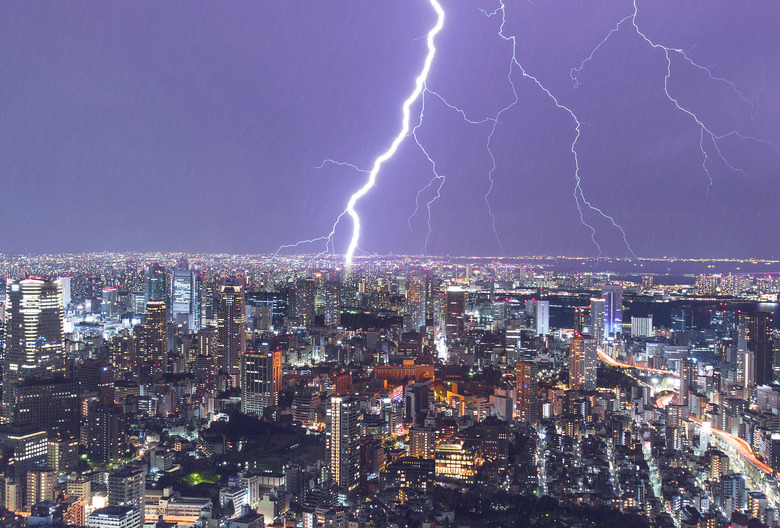The Effects Of Thunder & Lightning On Humans & Nature
Many dogs whimper and hide when a thunderstorm rages, as the crack of thunder scares them. Some dogs scuttle beneath beds until the storm passes. Small children and even some humans respond the same way to thunder and lightning, immediately seeking shelter of some kind, as natural instincts tell both humans and animals to be wary during such storms. While thunder may sound scary, it generally doesn't hurt humans or animals, but the same can't be said of lightning, which can kill a person or topple a tree when it strikes.
TL;DR (Too Long; Didn't Read)
An industrial electrical shock can carry between 20 to 63 kilovolts, but a lightning strike delivers a whopping 300 kilovolts. Between 1940 and 2003, 9,007 people have been killed because of lightning strikes, according to author Michael Largo in his book, "Final Exits: The Illustrated History of How We Die."
Struck by Lightning
Struck by Lightning
Electrical currents from lightning strikes maintain a shorter duration than industrial shocks, averaging a few milliseconds per strike, but they can travel up to 10 miles horizontally. When a human gets exposed to a lightning strike, an external flashover occurs where the electrical current passes over the surface of the body. This can result in burns, mostly in the upper and lower body, specifically the head, shoulders and neck. Injury can also occur by making the victim fall or by throwing him through the air. Immediate death from a lightning strike is usually attributed to cardiac or cardiopulmonary arrest.
Lightning’s Effects in Nature
Lightning's Effects in Nature
With a positive electrical charge, lightning travels between the negative base of a thunder cloud and the point of contact on Earth in about 30 seconds. Why specific objects attract lightning strikes is not yet fully understood by scientists, yet they know lightning tends to hit tall, free-standing structures, such as radio towers, telephones poles and trees, much more often than open ground. About 20 million lightning strikes hit the United States each year say scientists at Harvard University.
Sound Effects of Thunder
Sound Effects of Thunder
Thunder occurs as an acoustical effect of high temperature and pressure during a lightning storm. The change in pressure affects the human ears, which is how thunder is heard. The highest pressure in a storm happens a few inches away from the origin of the lightning strike, causing a rumbling noise.
Thunder’s Mechanical Effects
Thunder's Mechanical Effects
The pressure which results in thunder doesn't just have acoustical effects but mechanical ones as well. The high pressure of these lightning strikes can cause earthly damage, especially to metal objects. The pressure can be even more destructive when lightning strikes a small, closed area, such as a crack in a wall or a capillary in a tree. When pressure gets high enough and passes through tree capillary, the tree can explode.
Cite This Article
MLA
McDonaugh, Jane. "The Effects Of Thunder & Lightning On Humans & Nature" sciencing.com, https://www.sciencing.com/effects-thunder-lightning-humans-nature-8545584/. 25 April 2018.
APA
McDonaugh, Jane. (2018, April 25). The Effects Of Thunder & Lightning On Humans & Nature. sciencing.com. Retrieved from https://www.sciencing.com/effects-thunder-lightning-humans-nature-8545584/
Chicago
McDonaugh, Jane. The Effects Of Thunder & Lightning On Humans & Nature last modified March 24, 2022. https://www.sciencing.com/effects-thunder-lightning-humans-nature-8545584/
